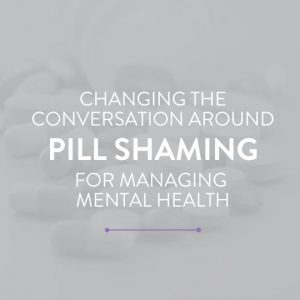
My responsible decision to have a NO OPIOIDS flag placed on my medical chart barred me from access to healthcare insurance. How many other millions of Americans are suffering in silence, out of fear that a stigmatizing label will block access to insurance, medical treatment and other necessary services?
Label avoidance costs lives. It happens when a person doesn’t seek care for a stigmatized mental health or physical condition–including substance misuse disorder–in order to avoid being assigned a stigmatizing label.
This is my personal story of discrimination based on my brave and responsible decision to mitigate any risk of dependance of prescription drugs.
FLAGGING MY CHART: NO OPIOIDS
In 2010, I was just more than a year into my sobriety and a doctor had prescribed me Vicodin for pain management. I took the medication as directed, but I immediately knew this was a problem for me.
I have an addictive personality. Whether it’s alcohol or opioids, I recognize I’m not able to have just one.
For a split-second, I thought about keeping it a secret. I liked the feeling opioids gave me. I knew if I stayed quiet, I could get more prescriptions. But if I did that, I would be addicted.
I went back to my doctor. It took incredible strength and commitment to get myself there, but once I did, I knew I had a new partner in my sobriety. I asked my doctor to flag my chart with “No Opioids” and moved on knowing that together, we did the right thing.
It was a decade before I really thought much more about it.
10 YEARS LATER: UNDERSTANDING THE FEAR AND FRUSTRATION OF LABEL AVOIDANCE
On April 1, 2020, I left my corporate job and stepped into my purpose of speaking on mental health in the workplace, teaching and training leaders how to normalize the conversation and create mentally healthier workplace cultures.
For the first time in my life, I needed to secure my own health insurance to replace my previously-provided corporate plan. I found a great plan, applied, and expected my approval notice in the mail shortly.
A few months later, I, indeed, got a letter.
It was a denial “due to confidential reasons.”
I wrote in for further details and got this response: “The confidential information for your medical record is history of alcohol abuse, history of drug abuse, and history of suicidal thoughts.”
That was a blow. Does the same type of denial happen to those who have well managed diabetes, heart disease or high blood pressure?
THREE LABELS "THEY" APPLIED TO ME
The health insurance company unfairly applied three highly stigmatizing labels to me without any attempt to open a dialogue about any of them.
Firstly, I was labeled an alcohol abuser, without any consideration to my 12 years (and counting) of sobriety;
Secondly, I was labeled a drug abuser, without any opportunity to provide insight into the “No Opioids” flag on my medical charts;
Thirdly, I was labeled as suicidal, without considering that I have extremely well-managed mental health.
“Does the same type of denial happen to those who have well managed diabetes, heart disease or high blood pressure?
It’s no wonder people choose not to disclose their mental health and substance misuse disorders to anyone, including medical professionals who can assist them in treatment–the long-term consequences of disclosing are crippling in and of themselves.
However, the consequences of not disclosing and getting help are potentially catastrophic and by that I mean, fatal. It’s critical to have open conversations about mental health because it saves lives.
STIGMA: A GREAT SOCIAL INJUSTICE
At this point, I would love to provide you with a detailed analysis of label avoidance statistics in the USA … but I can’t. Not reliably, anyway, with statistics within the last decade.
Much of the research in this area is on developing the label avoidance measure, which suggests researchers have not yet determined a reliable way to assess the impact.
So let’s zoom out. Label avoidance is one particular type of stigma; in fact, there are seven types of stigma. Straight from the National Alliance on Mental Illness, they are:
- Public Stigma: When the public endorses negative stereotypes and prejudices. The direct consequence is discrimination against people with mental health conditions.
- Self-Stigma: When a person with a mental health condition or substance misuse disorder internalizes public stigma.
- Perceived Stigma: The belief that others have negative thoughts about people with mental health conditions/
- Label Avoidance: When a person chooses not to seek mental health treatment to avoid being assigned a stigmatizing label. This is one of the most harmful forms for stigma.
- Stigma By Association: When the effects of stigma are extended to someone linked to a person with a mental health condition. This is also sometimes called Courtesy Stigma or Associative Stigma.
- Structural Stigma: Institutional policies or other societal structures that result in decreased opportunities for people with mental health conditions.
- Health Practitioner Stigma: Any time a health professional allows stereotypes and prejudices about mental health negatively affect a patient’s care.
Still, hard data on stigma in the USA is harder to find than I expected. This is indicative of its truly insidious nature, living and lurking in every facet of our lives and our workplaces.
HOW WE CAN KILL STIGMA,INSTEAD OF LETTING IT KILL US
I still carry the label of alcohol abuse, despite nearly a decade and half of sobriety. Being proactive about my inclination to substance misuse by asking to have my medical chart flagged “No Opioids” has now gained me a lifelong label of drug abuser.
Ultimately, I found health insurance through another carrier. But that first denial letter has been up on my refrigerator for 2 years now––as of April 2022.
This experience has also been on my heart for just as long. It was devastating at the time, but it’s the perfect illustration of label avoidance and I’ve decided to use it to inform others and create positive change.
Stigma loses power when we drag it out of its safe, dark corner and confront it. Interestingly, while hard data on stigma itself was hard to find, there is fantastic work being done to reduce stigma. It’s a hopeful sign that stigma’s devastating impact in our society is a hot topic of conversation, discussion and action.
FOUR KEY WAYS WE CAN REDUCE LABEL AVOIDANCE AND STIGMA IN THE WORKPLACE
- Education
- Mental health literacy campaigns
- Peer Support
- Policy change
All of these points are addressed in the 4 Pillars of Creating a Mentally Healthy Workplace Culture.
To learn more about how to incorporate custom 4 Pillars training into your next workplace leadership training session or summit, reach out to me or my team. We offer custom programs unique to your workplace needs and structure.

You are invited to schedule a consult to learn how to shift the dialog about mental health and create a mentally healthy workplace culture where everyone feels safe asking for help.




